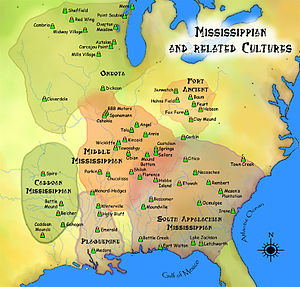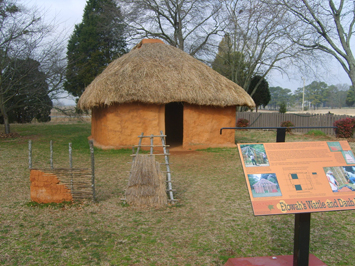
The Mississippian culture was a mound-building Native American culture that flourished in what is now the Midwestern, Eastern, and Southeastern United States. In Georgia, the Mississippian Period is divided into Early, Middle, and Late sub-periods. The Early Mississippian sub-period (A.D. 800-1100) was the time when the first chiefdoms developed in the state. Chiefdoms were a specific kind of human social organization with social ranking as a fundamental part of their structure. In ranked societies people belonged to one of two groupings, elites or commoners. Elites, who made up a relatively small percentage of chiefdom populations, had a higher social standing than commoners. Early Mississippian cultures had just transitioned from the Late Woodland period way of life. Different groups abandoned tribal lifeways for increasing complexity, sedentism, centralization, and agriculture.
The most significant Early Mississippian settlement was made at the Ocmulgee National Monument. The site developed many different types of shell-tempered pottery, but the narrow range of distribution of those wares demonstrates the site’s isolation from the surrounding settlements of the day.
Mississippian people lived in small villages and hamlets that rarely had more than a few hundred residents and in some areas also lived in single-family farms scattered across the landscape. Although there was a great deal of variation across Georgia, a typical Mississippian village consisted of a central plaza, residential zone, and defensive structures.
The plaza, located in the center of the town, served as a gathering place for many purposes, from religious to social. Houses were built around the plaza and were often arranged around small courtyards that probably served the households of several related families. Some, though not all, Mississippian villages also had defensive structures. Usually these took the form of a pole wall, known as a palisade; sometimes there was a ditch immediately outside the wall. These helped to keep unwelcome people and animals from entering the village.
This difference rested more on ideology than on such things as wealth or military power. For example, the Natchez of Louisiana, who were still organized as a chiefdom during the early 1700s, believed that their chief and his immediate family were descended from the sun, an important god to the Natchez. It was believed that the Natchez chief, probably like most Mississippian chiefs, could influence the supernatural world and therefore had the ability to ensure that important events like the rising of the sun, spring rains, and the fall harvest came on time.
Because of these supernatural connections, elites received special treatment. They had larger houses and special clothing and food, and they were exempt from many of life’s hard labors, like food production. The much more numerous commoners were the everyday producers of the society. They grew food, made crafts, and served as warriors and as laborers for public works projects.
They grew much of their food in small gardens using simple tools like stone axes, digging sticks, and fire. Corn, beans, squash, sunflowers, goosefoot, sumpweed, and other plants were cultivated. Wild plant and animal foods were also eaten. They gathered nuts and fruits and hunted such game as deer, turkeys, and other small animals. Mississippian people also collected fish, shellfish, and turtles from rivers, streams, and ponds.

Unlike contemporary people, Mississippian people spent much of their lives outdoors. Their houses were used mainly as shelter from inclement weather, sleeping in cold months, and storage. These were rectangular or circular pole structures; the poles were set in individual holes or in continuous trenches. Walls were made by weaving saplings and cane around the poles, and the outer surface of the walls was sometimes covered with sun-baked clay or daub. Roofs were covered with thatch, with a small hole left in the middle to allow smoke to escape. Inside the houses the hearth dominated the center of the living space. Low benches used for sleeping and storage ringed the outer walls, while short partitions sometimes divided this outer space into compartments. By today’s standards Mississippian houses were quite small, ranging from twelve feet to thirty feet on a side.
The earliest of the northern Georgia Mississippian cultures is Woodstock (A.D. 900-1000). It marks a transition from the Late Woodland into the Mississippian. There is some controversy as to whether the Woodstock culture should be considered terminal Late Woodland or emergent Mississippian. The Woodstock culture was identified from excavations at the Woodstock site (9CK2). Few other Woodstock sites have been excavated and there is a great deal of variability among them. There is little information on village and structure patterns, features, population and subsistence. Decorative motifs have been used to divide the Woodstock along the Etowah River into the Woodstock focus and the Proctor focus. Woodstock focus ceramics include sand tempered incised sherds while Proctor focus ceramics include sand tempered check stamped ones. However, complicated stamping is more common than either incising or check stamping in both foci.
The Etowah culture succeeds Woodstock with some overlap. Woodstock and early Etowah ceramics are often found in association. The Etowah culture is subdivided into four phases (Etowah I-IV).
Etowah I is the most poorly known of the phases. There is some dispute over whether it actually exists. If Etowah I is an actual phase, it dates between A.D. 1000-1050. There have been few pure Etowah I sites identified; however, there is controversy over what actually constitutes an Etowah I assemblage. Often a few ceramics are described as Etowah I on mixed Woodstock and/or Etowah II sites.
Halstead Plain came in the form of bowls or hooded, and sometimes effigy, water bottles.
Early Mississippian wares like Bibb Plain and Hawking Fabric Impressed were only known to exist in about a 10 mile radius of the site.
Brown’s Mount (named for the Brown’s Mount site located a few miles from the Ocmulgee National Monument) is now considered to be the same as Bibb Plain, but William Sears, noting the small Owl effigy heads along the rims of many vessels, felt them worthy of their own classification. Macon thick (right), Sixes Plain (not shown, and McDougal Plain (also not shown) are all part of the very limited presence of Georgia’s Early Mississippian culture.
In stark contrast to the small Early Mississippian cultural presence in central Georgia, Florida’s Fort Walton Incised and related sub-type pottery spread from central Florida to central Georgia and into Alabama.
The projectile points of this period were influenced largely by the invention of the bow and arrow. The earliest appearance small, triangular points at the McKeithen Weeden Island site near Lake City, Florida had developed this lithic assemblage some time after mound construction at the site about 300 A.D. The successful trade and consequent spread of that culture northward carried this new technology with it. From this point on, the historical record contains small triangular arrow points. The true “arrow head” was born.